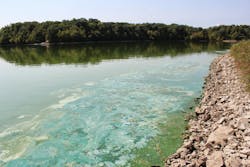Court Ruling Forces EPA Action on Mississippi River Pollution
The U.S. District Court in Eastern Louisiana ordered the U.S. Environmental Protection Agency (EPA) to determine within six months whether to set new limits on the pollution that is fueling the dangerous algae growth choking the waters throughout the Mississippi River basin, the Gulf of Mexico and waters across the country. Attorneys at the Natural Resources Defense Council (NRDC) led the suit, filed on behalf of several conservation groups and based on longstanding efforts by the Mississippi River Collaborative to break decades of inaction from the federal government on the issue of nitrogen and phosphorus pollution. These chemicals fuel the formation of the Gulf Dead Zone and toxic algae blooms and cause damage to drinking water supplies.
Nitrogen and phosphorus from sewage plants, urban storm water systems and agricultural operations fuels the growth of algae in waterways around the country. Algae, in turn, chokes out other aquatic life and can rob water of the oxygen that fish and shellfish need to survive. One of the most devastating consequences of this pollution has been the emergence of the dead zone in the Gulf of Mexico—an area the size of Connecticut where algal growth has driven levels of oxygen at the sea floor so low that virtually nothing can live there. Similar issues are driving the dramatic collapse of Lake Erie and threatening other portions of the Great Lakes.
The suit, filed a year and a half ago, challenged EPA’s denial of the Mississippi River Collaborative’s 2008 petition to EPA asking it to establish quantifiable standards and cleanup plans for nitrogen and phosphorus pollution. The suit charged that EPA had unlawfully refused to respond to the question posed to it, which is whether such federal action is necessary to comply with the Clean Water Act. The court agreed with plaintiffs, holding that the Agency’s refusal to provide a direct answer was unlawful.
The decision does not tell the EPA how to address the problem, only to make a decision on the issue. However, EPA has repeatedly acknowledged the severity of the problem and stated that federal intervention is appropriate because states are not doing enough to solve it.
Plaintiffs in the suit included Gulf Restoration Network, Waterkeeper Alliance, Environmental Law and Policy Center, Iowa Environmental Council, Missouri Coalition for the Environment, Prairie Rivers Network, Kentucky Waterways Alliance, Tennessee Clean Water Network, Minnesota Center for Environmental Advocacy, Sierra Club and NRDC. Attorneys at the Tulane Environmental Law Clinic, NRDC, and the Environmental Law and Policy Center brought the case.
Source: Natural Resources Defense Council


